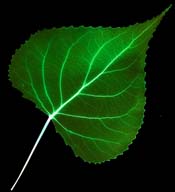|

WHEN
LISA SLOAN began her modeling studies almost a decade ago, she found
Scott Wing's data intriguing. She wanted to know what might have caused
the warm winters Wing and others described. At the time, scientists
assumed that warm ocean temperatures caused the warm inland winters
of 55 million years ago, but no one had tested the assumption. Sloan
decided to see if warm sea surface temperatures in a global climate
model would cause the ancient conditions paleontologists described.
The model she used was developed at the National
Center for Atmospheric Research and runs on a supercomputer. It's a
"terribly complex model developed by teams of dozens of scientists,"
she says. Climate researchers use the same type of model to predict
today's greenhouse warming or El Nino effects. The model is based on
the physics of the oceans and atmosphere. Researchers tuned it to simulate
modern-day weather conditions and longer-term climate patterns.
Like the fossil studies, then, paleoclimate modeling
relies on the assumption that the present reflects the past -- in other
words, that the physical laws linking the land, ocean, and atmosphere
today also operated 55 million years ago.
Sloan enters into the computer such information as
the geographic location of land and sea, the elevation of the land,
the presence or absence of ice sheets, the types of vegetation and soil,
how much energy arrives from the sun, and the composition of the atmosphere.
Then the model planet starts spinning and goes into orbit around the
sun. To phrase it simply, Sloan says, "I put in all that stuff and let
it compute."
The computer then begins to crunch the numbers. It
divides the Earth's surface into 16,200 squares and keeps track of approximately
75 variables for each square. It divides the atmosphere into 18 layers,
giving itself almost 22 million points to calculate. It calculates and
records these points every 30 minutes on the model Earth. (Time on the
model Earth is defined by its rotation just as it is on the real planet
-- one spin of the model Earth takes one day. The computer records the
variables 48 times in one model day.) 
As the model planet spins, the computer tracks variables
such as average annual temperature until the Earth has calmed down from
the initial shock of unusual conditions Sloan supplied it with. It typically
takes 12 model years for variables such as average annual temperatures
to stop fluctuating in the computer model Sloan uses. Then Sloan lets
it spin for a few more years. She analyzes the climate variables the
computer produces for those years only. The entire process takes about
300 computer hours on a Cray supercomputer.
When Sloan tested the idea that warm ocean temperatures
could cause mild inland winters, the model failed to "predict" the climate
conditions the fossils suggested. "I tried all kinds of outrageous temperatures
in the ocean and still got cold winters," she says.
Many paleontologists reacted strongly to her results,
insisting the model must be at fault. Despite the backlash, Sloan thinks
her results spurred on fossil gatherers who otherwise might have let
their finds get dusty in desk drawers. They now felt invigorated to
take a second look. Sloan says, "It brought more fossil data out and
gave them a framework to put their data in and a windmill to tilt at."
WING AGREES
that Sloan's 1990 paper did just that: it gave him a new way to think
about the climate of the Eocene. Before the modelers started analyzing
the reasons behind warm inland winters, Wing's main concern had been
studying ancient plants and how the climate had affected them. Sloan's
work made him realize that the implications of the paleoclimate extended
beyond its effects on the local flora to understanding the global climate.
"The models changed my thinking about why I do what I do," he says.
He now focuses more on climate, in addition to his
continuing work on the plants themselves. He hopes to find more fossil
sites in continental interiors to either support or alter the current
understanding of the Paleocene and Eocene climate. While at UC Santa
Cruz, Wing is also working with Sloan on modeling studies.
IN THE YEARS
following her 1990 paper, Sloan continued to seek the cause of the early
Eocene's warm winters in continental interiors. Inspired by a controversial
suggestion that high levels of greenhouse gases may have existed 55
million years ago, Sloan modeled three scenarios: the early Eocene world
with preindustrial levels of carbon dioxide, double preindustrial levels,
and six times preindustrial levels. None of these scenarios could predict
both Wyoming's warm winters and the ocean temperatures, implying that
greenhouse gases alone could not have caused that epoch's climate conditions.
However, in combination with some other trigger,
greenhouse gases may been responsible for the Eocene's warmth. To clarify
what role -- if any -- greenhouse gases played in the climate warming
and mild winters of 55 million years ago, Sloan needs more data about
that epoch's greenhouse gas levels.
 Now she and Wing are changing the continent boundaries in the model,
since ocean levels were different and the continental plates have moved
in the past 55 million years. The two are also focusing on regional
geography. Sloan recently added a large lake in her model of western
North America and found warmer winters near the lake. Again she concludes
that she needs more data -- in this case, about regional land elevation
and where lakes were historically.
Now she and Wing are changing the continent boundaries in the model,
since ocean levels were different and the continental plates have moved
in the past 55 million years. The two are also focusing on regional
geography. Sloan recently added a large lake in her model of western
North America and found warmer winters near the lake. Again she concludes
that she needs more data -- in this case, about regional land elevation
and where lakes were historically.
Clouds are another factor that may have been important
55 million years ago. In recent work, Sloan has tried adding high clouds
over the polar regions, and she finds that winters in mid- to high latitudes
are much warmer when she does this. The model suggests they could be
significant, but clouds' importance in the Eocene's climate will be
hard to judge until scientists learn more about their location in ancient
times. Researchers continually update the models to make them predict
today's climate more precisely, in hopes of predicting future climes.
But an inherent weakness in using models to study
ancient or future climates remains: the models are tuned to today's
climate. "It's like you've tuned a car to run really well at sea level,"
Sloan says, "but the minute you take it up to 9,000 feet, it's a dog."
The added complication with climate models is that, unlike cars, they
don't announce their struggles by sputtering and overheating. Researchers
must seek out places where the models fail, and then improve them. "That
doesn't give me and other people complete confidence that they're really
accurate for other time periods," she says. "I've never considered that
the models were completely right."
A model's best use, then, is testing the potential
merit of hypotheses.
Today, few scientists disagree with Sloan that warm
oceans could not have single-handedly warmed the climate interiors.
The model results point to gaps in geologic and fossil data. No paleontologist
or geologist has yet found evidence that clearly suggests a cause for
the early Eocene climate. If Sloan manages to simulate the environment
that paleontologists describe, she will still have no proof that those
conditions actually existed. "Even if I did find a combination of model
factors that produced the climate conditions dictated by the fossil
evidence, it would take you right back to the geologic data," she says.
Paleontologists' next step would then be to look for more crocodiles
and palm trees at midlatitudes on continents not yet examined, such
as Asia. Then fossil hunters could throw another challenge to modelers.
"I tend to keep an open mind about how good the model
is," she says. "The data interpretations aren't perfect either. You're
looking at two imperfect worlds and trying to get them to match." Sloan
doubts these two worlds ever will coincide. But by working together,
scientists like Sloan and Wing seem likely to bring them closer together.
<<
previous || next >>
|



 Now she and Wing are changing the continent boundaries in the model,
since ocean levels were different and the continental plates have moved
in the past 55 million years. The two are also focusing on regional
geography. Sloan recently added a large lake in her model of western
North America and found warmer winters near the lake. Again she concludes
that she needs more data -- in this case, about regional land elevation
and where lakes were historically.
Now she and Wing are changing the continent boundaries in the model,
since ocean levels were different and the continental plates have moved
in the past 55 million years. The two are also focusing on regional
geography. Sloan recently added a large lake in her model of western
North America and found warmer winters near the lake. Again she concludes
that she needs more data -- in this case, about regional land elevation
and where lakes were historically.